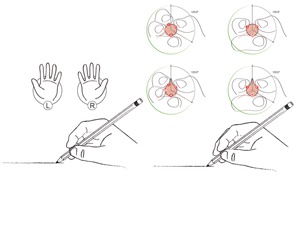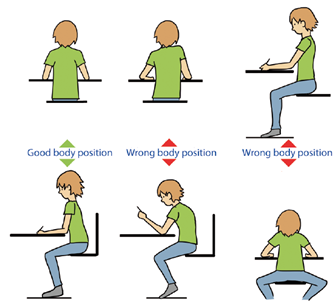Tips to learn handwriting
It is essential to adopt good habits right from the start. According to the psycho-motor therapist, Philippe Kostka, children can begin to learn good posture as soon as they are seated correctly at their desk. At the same time, getting a child to hold the writing tool correctly at the outset is also important, as it can be difficult to correct handgrips once the child is used to it.
 Correct finger positioning
Correct finger positioning
Here are several tips to help children learn how to position their fingers:
- The pencil or pen is held between thumb and index finger, resting on the middle finger. This is called the tripod grip.
- The instrument should be held near the tip, but far enough away to allow the child to see the writing on the page properly. Finger should remain flexible and nimble, but some muscle tone is needed to form the outlines that will later create letters, words and sentences.
- The paper at an angle, so that there is a total liberty of movement, the child should be encouraged to create movements, such as flexion-extension of the wrist.
- The other hand (left for right-handers) should hold the page steady and keep the body balanced.
- Move the writing hand from left to write when writing.

Correct body positioning
Good posture for writing well cannot be acquired in a space of few days. Throughout their time in nursery, children first have to learn to understand what is known as «body image». They practice identifying the various parts of the body, in order to control movement and spatial awareness, up, down, left to right, etc., learning to move the arm separately from the body, aligning objects, tracing lines and curves with a finger, understanding what is meant by horizontal and vertical.
Then the child has to adopt the correct body position for writing, helped at home by you, if possible. In a well-lit place, get your child to sit on a suitably sized chair, with their feet flat on the ground, knees below thigh level, back straight and leaning slightly forward. The elbows and forearms should be free to move easily. The non-writing arm can be used for support, as long as the back remains straight. All the muscles in the hand should be at rest, with the forearm extended naturally, without flexing or rotating.
Game proposed:
Ask your child to show you the good position and take a picture. Then analyze with your child how the position can be improved. Take another picture to see the difference.
Text reviewed by David Boisdevesys, BIC Product designer and Ergonomist, and Philippe Kotska, psychomotrician.


